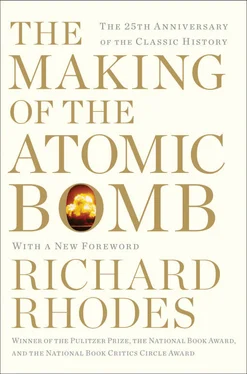The man who would found big-machine physics in America arrived at Berkeley one year before Oppenheimer, in 1928. Ernest Orlando Lawrence was three years older than the young theoretician and in many ways his opposite, an extreme of the composite American type. 533Both he and Oppenheimer were tall and both had blue eyes and high expectations. But Ernest Lawrence was an experimentalist, from prairie, small-town South Dakota; of Norwegian stock, the son of a superintendent of schools and teachers’ college president; domestically educated through the Ph.D. at the Universities of South Dakota, Minnesota and Chicago and at Yale; with “almost an aversion to mathematical thought” according to one of his protégés, the later Nobel laureate Luis W. Alvarez; a boyish extrovert whose strongest expletives were “Sugar!” and “Oh fudge!” who learned to stand at ease among the empire builders of patrician California’s Bohemian Grove; a master salesman who paid his way through college peddling aluminum kitchenware farm to farm; with a gift for inventing ingenious machines. 534Lawrence arrived at Berkeley from Yale in a Reo Flying Cloud with his parents and his younger brother in tow and put up at the faculty club. Fired compulsively with ambition—for physics, for himself—he worked from early morning until late at night.
As far back as his first year of graduate school, 1922, Lawrence had begun to think about how to generate high energies. His flamboyant, fatherly mentor encouraged him. William Francis Gray Swann, an Englishman who had found his way to Minnesota via the Department of Terrestrial Magnetism of the District of Columbia’s private Carnegie Institution, took Lawrence along with him first to Chicago and then to Yale as he moved up the academic ladder himself. After Lawrence earned his Ph.D. and a promising reputation Swann convinced Yale to jump him over the traditional four years of instructorship to a starting position as assistant professor of physics. Swann’s leaving Yale in 1926 was one reason Lawrence had decided to move West, that and Berkeley’s offer of an associate professorship, a good laboratory, as many graduate-student assistants as he could handle and $3,300 a year, an offer Yale chose not to match.
At Berkeley, Lawrence said later, “it seemed opportune to review my plans for research, to see whether I might not profitably go into nuclear research, for the pioneer work of Rutherford and his school had clearly indicated that the next great frontier for the experimental physicist was surely the atomic nucleus.” 535But as Luis Alvarez explains, “the tedious nature of Rutherford’s technique… repelled most prospective nuclear physicists. Simple calculations showed that one microampere of electrically accelerated light nuclei would be more valuable than the world’s total supply of radium—if the nuclear particles had energies in the neighborhood of a million electron volts.” 536
Alpha particles or, better, protons could be accelerated by generating them in a discharge tube and then repelling or attracting them electrically. But no one knew how to confine in one place for any useful length of time, without electrical breakdown from sparking or overheating, the million volts that seemed to be necessary to penetrate the electrical barrier of the heavier nuclei. The problem was essentially mechanical and experimental; not surprisingly, it attracted the young generation of American experimental physicists who had grown up in small towns and on farms experimenting with radio. By 1925 Lawrence’s boyhood friend and Minnesota classmate Merle Tuve, another protégé of W. F. G. Swann now installed at the Carnegie Institution and working with three other physicists, had managed brief but impressive accelerations with a high-voltage transformer submerged in oil; others, including Robert J. Van de Graaff at MIT and Charles C. Lauritsen at Caltech, were also developing machines.
Lawrence pursued more promising studies but kept the high-energy problem in mind. The essential vision came to him in the spring of 1929, four months before Oppenheimer arrived. “In his early bachelor days at Berkeley,” writes Alvarez, “Lawrence spent many of his evenings in the library, reading widely…. Although he passed his French and German requirements for the doctor’s degree by the slimmest of margins, and consequently had almost no facility with either language, he faithfully leafed through the back issues of the foreign periodicals, night after night.” 537Such was the extent of Lawrence’s compulsion. It paid. He was skimming the German Arkiv für Elektrotechnik, an electrical-engineering journal physicists seldom read, and happened upon a report by a Norwegian engineer named Rolf Wideröe, Über ein neues Prinzip zur Herstellung hoher Spannungen: “On a new principle for the production of higher voltages.” The title arrested him. He studied the accompanying photographs and diagrams. They explained enough to set Lawrence off and he did not bother to struggle through the text.
Wideröe, elaborating on a principle established by a Swedish physicist in 1924, had found an ingenious way to avoid the high-voltage problem. He mounted two metal cylinders in line, attached them to a voltage source and evacuated them of air. The voltage source supplied 25,000 volts of high-frequency alternating current, current that changed rapidly from positive to negative potential. That meant it could be used both to push and to pull positive ions. Charge the first cylinder negatively to 25,000 volts, inject positive ions into one end, and the ions would be accelerated to 25,000 volts as they left the first cylinder for the second. Alternate the charge then—make the first cylinder positive and the second cylinder negative—and the ions would be pushed and pulled to further acceleration. Add more cylinders, each one longer than the last to allow for the increasing speed of the ions, and theoretically you could accelerate them further still, until such a time as they scattered too far outward from the center and crashed into the cylinder walls. Wideröe’s important innovation was the use of a relatively small voltage to produce increasing acceleration. “This new idea,” says Lawrence, “immediately impressed me as the real answer which I had been looking for to the technical problem of accelerating positive ions, and without looking at the article further I then and there made estimates of the general features of a linear accelerator for protons in the energy range above one million [volts].” 538
Lawrence’s calculations momentarily discouraged him. The accelerator tube would be “some meters in length,” too long, he thought, for the laboratory. (Linear accelerators today range in length up to two miles.) “And accordingly, I asked myself the question, instead of using a large number of cylindrical electrodes in line, might it not be possible to use two electrodes over and over again by sending the positive ions back and forth through the electrodes by some sort of appropriate magnetic field arrangement.” The arrangement he conceived was a spiral. “It struck him almost immediately,” Alvarez later wrote, “that one might ‘wind up’ a linear accelerator into a spiral accelerator by putting it in a magnetic field,” because the magnetic lines of force in such a field guide the ions. 539Given a welltimed push, they would swing around in a spiral, the spiral becoming larger as the particles accelerated and were thus harder to confine. Then, making a simple calculation for the magnetic-field effects, Lawrence uncovered an unsuspected advantage to a spiral accelerator: in a magnetic field slow particles complete their smaller circuits in exactly the same time faster particles complete their larger circuits, which meant they could all be accelerated together, efficiently, with each alternating push.
Читать дальше












